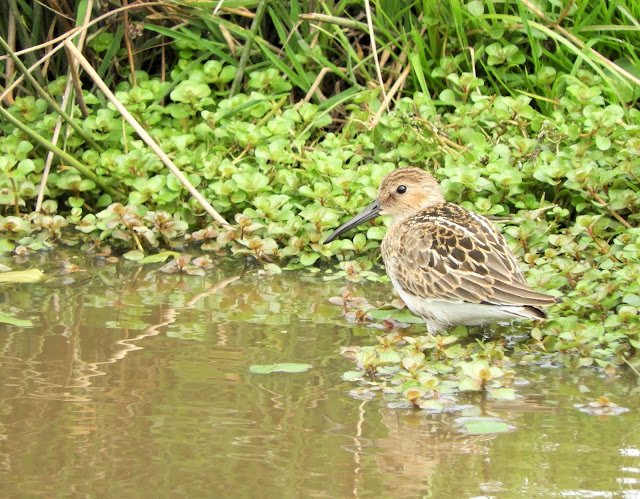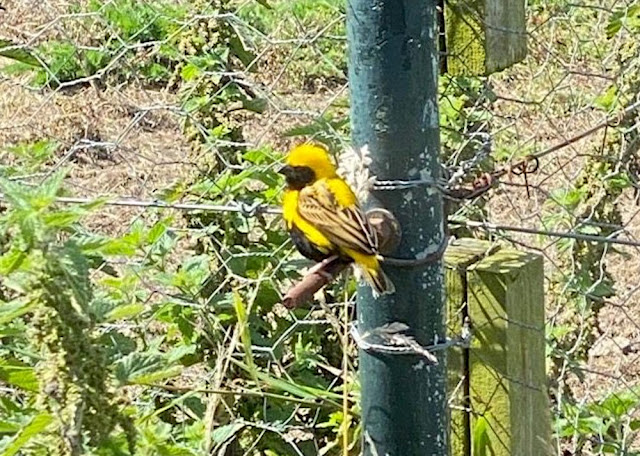The island's resident Starlings are now forming big pre-roost flocks around the Village, a handful of Lundy Cabbage flowers hang on from delicate stems as they protrude from clumps of browning bracken, the first Fulmar chicks have left their cosy ledges for a new life on the open sea, and the cries of young gulls along the sidelands have now been replaced by the wails of hauled-out seals ready for the breeding season. The end-of-summer season is blending magically into the start of autumn but summer isn’t going out without a wildlife-filled bang!
Weather-wise – from the end of the last post (9th) up until the 21st, Lundy was subjected to some rather prolonged, grey, overcast and wet conditions, with frequent spells of mist and low cloud and, of course, a number of days with strong westerly winds – particularly on the 15th when gusts were just shy of gale force. Thankfully, a much-welcomed spell of high pressure arrived on the night of the 22nd bringing more summer-like conditions up until the 30th. Skies cleared, temperatures rose and the winds turned to the east – ideal conditions for bringing a wonderful diversity and number of southbound migrants to the island.
 |
| The warm, settled weather over the last week has urged more ants to take to the wing, including this swarm at South West Point, 26 Aug © Dean Jones |
Birding highlights from this period included the Marsh Harrier, which remained on the island from earlier in the month until the 12th at least, mostly seen quartering the slopes and combes in the north-east of the island. However, it did travel further south on the 11th when it was perched upon a recently deceased sheep on Ackland's Moor, being seen by Ash Garfoot from his bathroom window in Old Light Cottage.
Other star birds included a Wryneck, which found itself in the shelf of a mist-net in Millcombe on the 29th. The second Wood Sandpiper of the year flew low over the Village on the 15th, two Little Egrets (the first of the year) were present together in the Devil’s Kitchen on the evening of the 29th, and adult and young Water Rails were heard calling to one another from Quarter Wall on the 25th – confirming breeding for another year. Nearby, the first Whinchat of the autumn was perched at the end of 'Pointless Wall' (on the northern side of the Airfield) on the same date, with another at Quarter Wall on the 28th, and Spotted Flycatchers started moving through the island from the 23rd, with spectacular numbers on the 26th (24) and 27th (35). Pied Flycatchers too have been arriving in good numbers since the 25th, with higher counts including eight on the 25th, four on the 26th and a super 20 birds on the 27th – though this is still a ways off the record of 100 on 2nd September 1989!
Other south-bound migrants included a juvenile Cuckoo on the 23rd & 24th, single Swifts on four dates, a lone Teal periodically on Brick Field Pond, up to 12 Woodpigeon logged each day, a single Collared Dove singing in Millcombe on the 23rd, lone Cormorants perched on South West Point and South East Point on the 18th and 29th respectively, a Grey Heron over the Beach Road on the 29th, a stunning adult male Merlin perched below the Terrace on the 28th, and up to three Kestrels present daily.
Waders have also continued to move through, with singles of Curlew logged on the 10th and 12th, the first southbound Whimbrel of the year on Rat Island on the 13th and five in Barton Field on the 19th. One or two Dunlin were logged on seven dates, mostly flyovers apart from a bird at Brick Field Pond on the 23rd, and a single Snipe was logged at Pondsbury, also on the 23rd. A Green Sandpiper flew south past the Landing Bay on the 18th and three were logged overhead on the 31st, two Common Sandpiper were heard calling along the east coast on the 23rd, single Ringed Plovers flew over the island on the 21st and 28th, with two on the 23rd, two Golden Plover were on the Airfield on the 23rd, 24th and 31st, and single flyover Turnstones were logged on the 24th and 31st, whilst another spent two days in the Landing Bay on the 26th & 27th. Finally, a Greenshank flew over the island on the 26th, single Redshanks were logged on the 28th (Pondsbury) and the 30th (Village), and a juvenile Knot dropped into Rocket Pole Pond on the 30th – the first for Lundy since 2018.
Onto the songbirds, and Willow Warblers continued moving through in good numbers each day, with high counts of 28 on the 12th, 36 on the 16th and at least 70 on the 27th. The first Reed Warblers of the ornithological autumn were logged in the Secret Garden on the 26th, followed by two together in the Government House tree nursery on the 27th. A single Grasshopper Warbler was flushed from St John’s Valley on the 20th, two Garden Warblers were in Millcombe on the 12th, with a single bird on the 26th, and small numbers of Chiffchaff, Sedge Warbler, Blackcap and Whitethroat were logged each day – the first of these including a pair feeding a second brood of three chicks in Millcombe on the 21st.
Hirundine passage has picked up a bit too over the past few weeks – namely Swallow (max 38 on the 23rd) and Sand Martin (max 25 on the 26th). The first Firecrest of the autumn was in Millcombe pines on the 28th and still present on 31st, accompanied by a single Goldcrest on the 30th and 31st. Two southbound Yellow Wagtails were logged on the mornings of the 27th and 30th, followed by four in Brick Field on the 31st, a single White Wagtail was next to the water tanks on the 31st, and the first southbound Tree Pipits arrived on the 16th and have since been logged on nine days (max six over the Village/Millcombe area on the 28th), along with a small but noticeable increase in Pied Wagtails and Meadow Pipits across the island. Wheatears too were logged in low double-digit counts most days and the post-breeding Linnet flocks are still growing, particularly in Middle Park where a flock of 170 was seen on the 27th.
 |
| One of four Yellow Wagtails in Brick Field, with Boris-the-Bull, 31 Aug © Dean Jones |
 |
| Wheatear ruffled by the easterly breeze, Brick Field, 25 Aug © Dean Jones |
 |
| Young Linnet, Rocket Pole Pond, 18 Aug © Dean Jones |
Reports over the radio on the 24th of a bright yellow finch-like bird on the fence of the Lodge garden had members of the Conservation Team running up the hill to investigate. By the time we got there, however, the bird had gone but luckily the finder, Paul Sofield, managed to get some shots of the mystery bird on his mobile phone. As you can see from the record shot below, the bird in question turned out to be a Yellow-crowned Bishop, a species native to numerous African countries south of the Sahara, occurring also in parts of Spain and Portugal where it was accidently introduced.
Despite this bird being of captive origin from an aviary in North Devon, it is incredible that it made the jump over the sea to the island. It just goes to show, you never know what you’re going to find on Lundy! Since the 24th, the bird has taken a liking to South West Field and the Aerogenerator (Lighthouse) Field, where it was seen periodically up until the 31st.
Other exciting avian news included a breeding colour-ringed Kittiwake in Jenny’s Cove, found by Eleanor Grover whilst surveying Puffins on the 18th July. FX21721 or orange/red/metal (left leg), red/blue/blue (right leg) was hatched at Pointe du Raz, Plogoff, Finistère, Brittany, France in 2009 and had not been resighted until now. It is highly possible that this bird may have bred at Jenny’s Cove for several years but gone unnoticed until now. Bravo Eleanor!
The coming of August not only brings wonderful migrant birds but also numerous Atlantic Grey Seals to the island, as they arrive en masse to give birth in sheltered coves and tucked-away beaches. At the moment the pupping season has been rather slow and late compared to most years, with the first pup arriving on 21st August – nearly four weeks later than the first of 2020. So far we have found four 'white coat' pups; fingers crossed we’ll be finding plenty more in the weeks to come (we found 50 pups in 2020). A full seal count along the east coast on the 11th resulted in a super 244 animals – the highest number of these playful pinnipeds yet to be recorded around Lundy!
Nine species of butterfly were noted during this period, including a few Painted Ladies on four dates, a single Gatekeeper on the 25th, and good numbers of Common Blue and Small Heath on a few days – particularly on days with settled weather.
The Millcombe mothtrap has also provided some exciting finds throughout – including two new species for the island! The first of these came in the form of a Slender Brindle on the 11th, a rather localised species here in the UK where its larvae feed on a range of woodland grasses. The second, a Small Dusky Wave on the 24th, is a much more common and widespread species on the mainland.
Another exciting find, on the 13th, was the island's second record of the fabulous-looking Burnished Brass. Again this is a common species on the mainland, but the last to be found on Lundy was 78 years ago in 1943!
The best of the rest included good numbers of Scarce Footman on the 11th (35), as well as a handful of migrants including Rush Veneer, Silver Y, Dark Sword Grass and Diamond-backed Moth.
Report composed of sightings from Dan Brown, Pete Clabburn, Charles Crundwell, Jamie Dunning, Ash & Kobe Garfoot, Eleanor Grover, Dean Jones, Alan Rowland, Chloe Woolfenden and Amanda Yates.














No comments:
Post a Comment